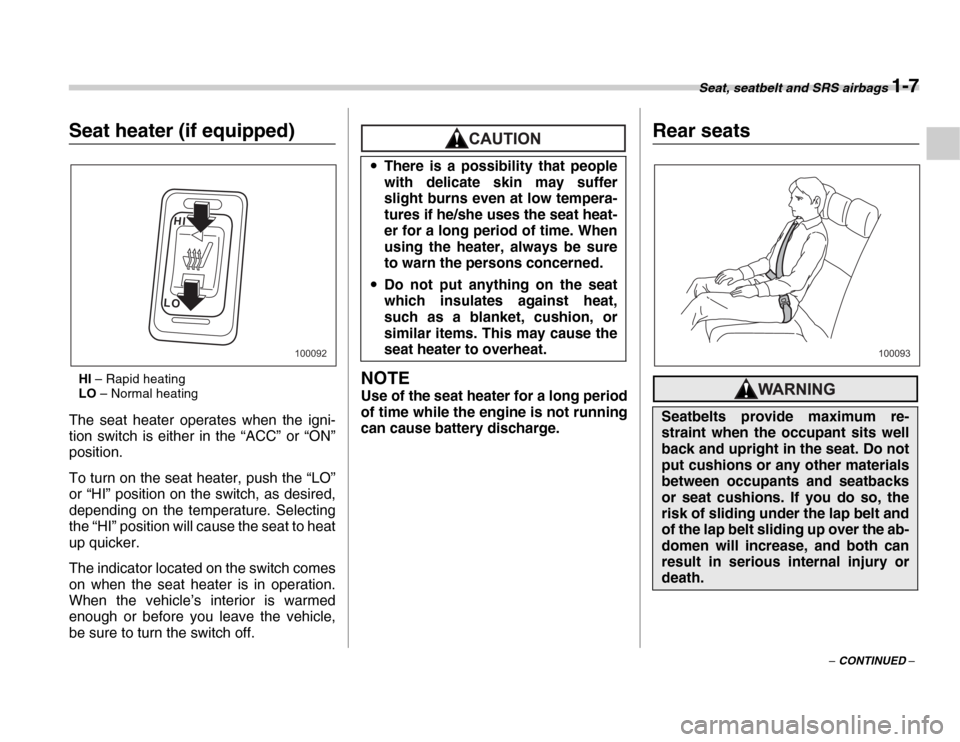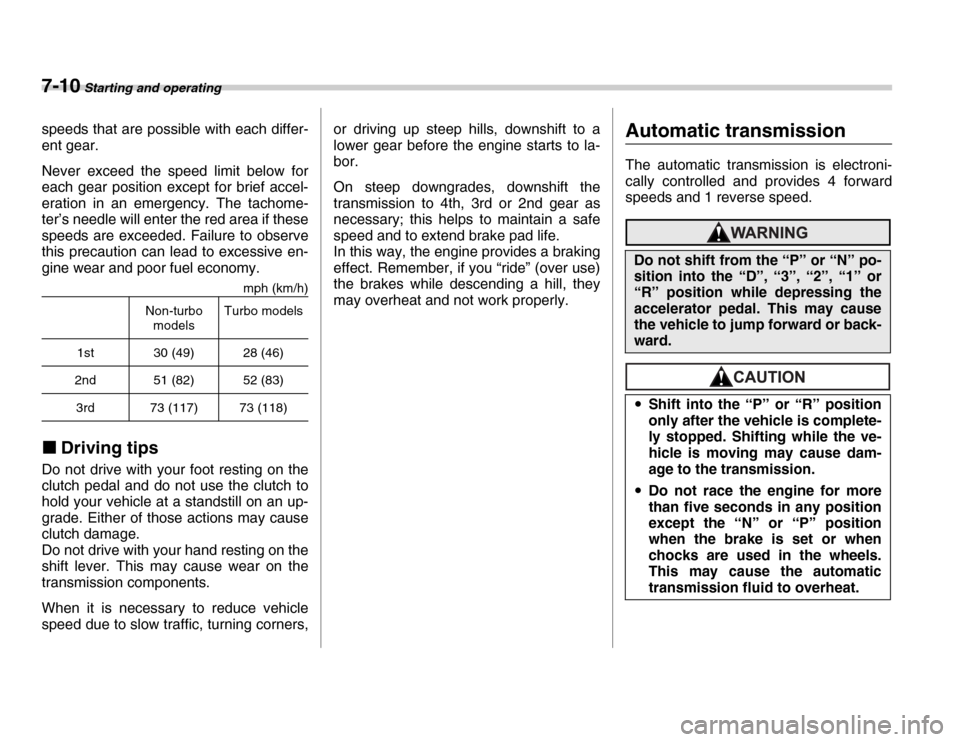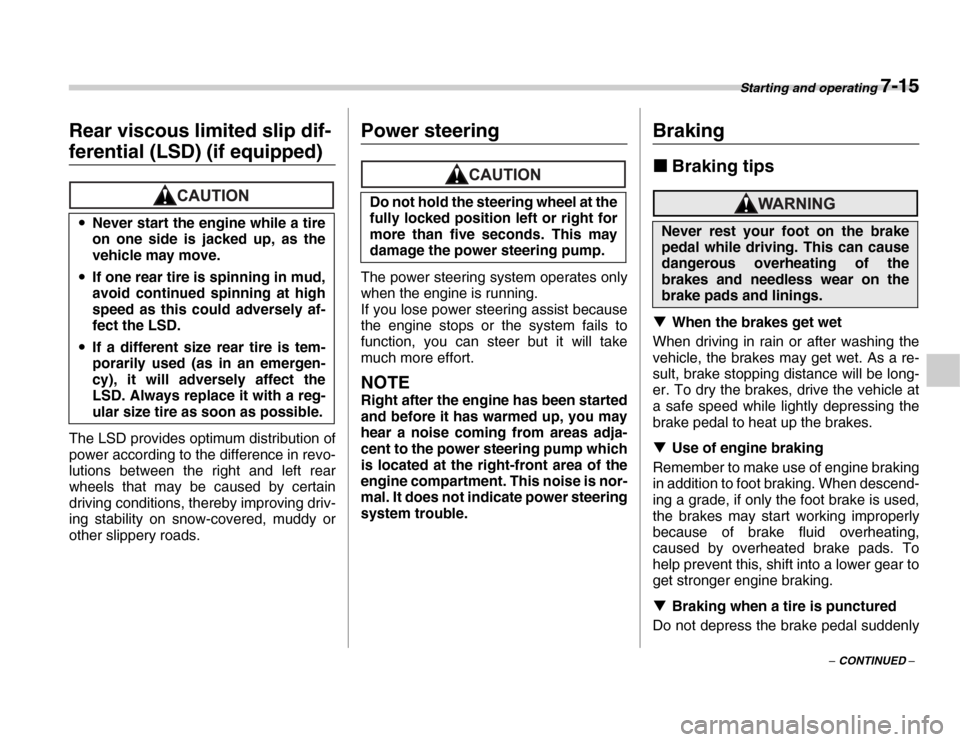2007 SUBARU FORESTER engine overheat
[x] Cancel search: engine overheatPage 4 of 356

2
the climate control.
Chapter 5: Audio
This chapter informs you how to operate
your audio system.
Chapter 6: Interior equipment
This chapter informs you how to operate
interior equipment.
Chapter 7: Starting and operating
This chapter informs you how to start and
operate your SUBARU.
Chapter 8: Driving tips
This chapter informs you how to drive your
SUBARU in various conditions and ex-
plains some safety tips on driving.
Chapter 9: In case of emergency
This chapter informs you what to do if you
have a problem while driving, such as a
flat tire or engine overheating.
Chapter 10: Appearance care
This chapter informs you how to keep your
SUBARU looking good.
Chapter 11: Maintenance and service
This chapter informs you when you need
to take your SUBARU to the dealer for
scheduled maintenance and informs you
how to keep your SUBARU running prop-
erly.
Chapter 12: Specifications
This chapter informs you about dimension
and capacities of your SUBARU.
Chapter 13: Consumer information and
Reporting safety defectsThis chapter informs you about Uniform
tire quality grading standards and Report-
ing safety defects.
Chapter 14: Index
This is an alphabetical listing of all that’s in
this manual. You can use it to quickly find
something you want to read.
�„ Safety warnings
You will find a number of WARNINGs,
CAUTIONs and NOTEs in this manual.
These safety warnings alert you to poten-
tial hazards that could result in injury to
you or others.
Please read these safety warnings as well
as all other portions of this manual careful-
ly in order to gain a better understanding
of how to use your SUBARU vehicle safe-
ly.NOTE
A NOTE gives information or sugges-
tions how to make better use of your
vehicle. �„ Safety symbol
You will find a circle with a slash through it
in this manual. This symbol means “Do
not”, “Do not do this”, or “Do not let this
happen”, depending upon the context.
A WARNING indicates a situation in
which serious injury or death could
result if the warning is ignored.
A CAUTION indicates a situation in
which injury or damage to your vehi-
cle, or both, could result if the cau-
tion is ignored.
000013
Page 35 of 356

Seat, seatbelt and SRS airbags 1-7
– CONTINUED –
Seat heater (if equipped)HI – Rapid heating
LO – Normal heating
The seat heater operates when the igni-
tion switch is either in the “ACC” or “ON”
position.
To turn on the seat heater, push the “LO”
or “HI” position on the switch, as desired,
depending on the temperature. Selecting
the “HI” position will cause the seat to heat
up quicker.
The indicator located on the switch comes
on when the seat heater is in operation.
When the vehicle’s interior is warmed
enough or before you leave the vehicle,
be sure to turn the switch off.
NOTE
Use of the seat heater for a long period
of time while the engine is not running
can cause battery discharge.
Rear seats
HI
LO
100092
�y There is a possibility that people
with delicate skin may suffer
slight burns even at low tempera-
tures if he/she uses the seat heat-
er for a long period of time. When
using the heater, always be sure
to warn the persons concerned.
�y Do not put anything on the seat
which insulates against heat,
such as a blanket, cushion, or
similar items. This may cause the
seat heater to overheat.
Seatbelts provide maximum re-
straint when the occupant sits well
back and upright in the seat. Do not
put cushions or any other materials
between occupants and seatbacks
or seat cushions. If you do so, the
risk of sliding under the lap belt and
of the lap belt sliding up over the ab-
domen will increase, and both can
result in serious internal injury or
death.
100093
Page 208 of 356

7-10 Starting and operating
speeds that are possible with each differ-
ent gear.
Never exceed the speed limit below for
each gear position except for brief accel-
eration in an emergency. The tachome-
ter’s needle will enter the red area if these
speeds are exceeded. Failure to observe
this precaution can lead to excessive en-
gine wear and poor fuel economy.mph (km/h)
�„ Driving tips
Do not drive with your foot resting on the
clutch pedal and do not use the clutch to
hold your vehicle at a standstill on an up-
grade. Either of those actions may cause
clutch damage.
Do not drive with your hand resting on the
shift lever. This may cause wear on the
transmission components.
When it is necessary to reduce vehicle
speed due to slow traffic, turning corners, or driving up steep hills, downshift to a
lower gear before the engine starts to la- bor.
On steep downgrades, downshift the
transmission to 4th, 3rd or 2nd gear as
necessary; this helps to maintain a safe
speed and to extend brake pad life.
In this way, the engine provides a braking
effect. Remember, if you “ride” (over use)
the brakes while descending a hill, they
may overheat and not work properly.Automatic transmission
The automatic transmission is electroni-
cally controlled and provides 4 forward
speeds and 1 reverse speed.
Non-turbo
models Turbo models
1st 30 (49) 28 (46)
2nd 51 (82) 52 (83)
3rd 73 (117) 73 (118)
Do not shift from the “P” or “N” po-
sition into the “D”, “3”, “2”, “1” or
“R” position while depressing the
accelerator pedal. This may cause
the vehicle to jump forward or back-
ward. �y Shift into the “P” or “R” position
only after the vehicle is complete-
ly stopped. Shifting while the ve-
hicle is moving may cause dam-
age to the transmission.
�y Do not race the engine for more
than five seconds in any position
except the “N” or “P” position
when the brake is set or when
chocks are used in the wheels.
This may cause the automatic
transmission fluid to overheat.
Page 213 of 356

Starting and operating 7-15
– CONTINUED –
Rear viscous limited slip dif-
ferential (LSD) (if equipped)
The LSD provides optimum distribution of
power according to the difference in revo-
lutions between the right and left rear
wheels that may be caused by certain
driving conditions, thereby improving driv-
ing stability on snow-covered, muddy or
other slippery roads.
Power steering
The power steering system operates only
when the engine is running.
If you lose power steering assist because
the engine stops or the system fails to
function, you can steer but it will take
much more effort.
NOTE
Right after the engine has been started
and before it has warmed up, you may
hear a noise coming from areas adja-
cent to the power steering pump which
is located at the right-front area of the
engine compartment. This noise is nor-
mal. It does not indicate power steering
system trouble.
Braking �„
Braking tips
�TWhen the brakes get wet
When driving in rain or after washing the
vehicle, the brakes may get wet. As a re-
sult, brake stopping distance will be long-
er. To dry the brakes, drive the vehicle at
a safe speed while lightly depressing the
brake pedal to heat up the brakes. �T Use of engine braking
Remember to make use of engine braking
in addition to foot braking. When descend-
ing a grade, if only the foot brake is used,
the brakes may start working improperly
because of brake fluid overheating,
caused by overheated brake pads. To
help prevent this, shift into a lower gear to
get stronger engine braking. �T Braking when a tire is punctured
Do not depress the brake pedal suddenly
�y
Never start the engine while a tire
on one side is jacked up, as the
vehicle may move.
�y If one rear tire is spinning in mud,
avoid continued spinning at high
speed as this could adversely af-
fect the LSD.
�y If a different size rear tire is tem-
porarily used (as in an emergen-
cy), it will adversely affect the
LSD. Always replace it with a reg-
ular size tire as soon as possible.
Do not hold the steering wheel at the
fully locked position left or right for
more than five seconds. This may
damage the power steering pump.
Never rest your foot on the brake
pedal while driving. This can cause
dangerous overheating of the
brakes and needless wear on the
brake pads and linings.
Page 248 of 356

8-24 Driving tips
olution. �yAvoid uneven steering, sharp turns and
rapid lane changes. �y Slow down before turning. Make a long-
er than normal turning radius because the
trailer wheels will be closer than the vehi-
cle wheels to the inside of the turn. In a
tight turn, the trailer could hit your vehicle. �y Crosswinds will adversely affect the
handling of your vehicle and trailer, caus-
ing sway. Crosswinds can be due to
weather conditions or the passing of large
trucks or buses. If swaying occurs, firmly
grip the steering wheel and slow down im-
mediately but gradually. �y When passing other vehicles, consider-
able distance is required because of the
added weight and length caused by at-
taching the trailer to your vehicle. 1) Left turn
2) Right turn
�y Backing up with a trailer is difficult and
takes practice. When backing up with a
trailer, never accelerate or steer rapidly.
When turning back, grip the bottom of the
steering wheel with one hand and turn it to
the left for a left turn, and turn it to the right
for a right turn.�y If the ABS warning light illuminates
while the vehicle is in motion, stop towing
the trailer and have repairs performed im-
mediately by the nearest SUBARU dealer. �T Driving on grades
�y Before going down a steep hill, slow
down and shift into lower gear (if neces-
sary, use 1st gear) in order to utilize the
engine braking effect and prevent over- heating of your vehicle’s brakes. Do not
make sudden downshifts. �y
When driving uphill in hot weather, the
air conditioner may turn off automatically
to protect the engine from overheating. �y When driving uphill in hot weather, pay
attention to the water temperature gauge
pointer (for all vehicles) and AT OIL TEMP
warning light (for AT vehicles) since the
engine and transmission are relatively
prone to overheating under these condi-
tions. If the water temperature gauge
pointer approaches the OVERHEAT zone
or the AT OIL TEMP warning light illumi-
nates, immediately switch off the air con-
ditioner and stop the vehicle at the nearest
safe place. Refer to the “Engine overheat-
ing” section in chapter 9, and “Warning
and indicator lights” section in chapter 3. �y If your vehicle has an automatic trans-
mission, avoid using the accelerator pedal
to stay stationary on an uphill slope in-
stead of using the parking brake or foot
brake. That may cause the transmission
fluid to overheat. �y If your vehicle has an automatic trans-
mission, place the selector lever as fol-
lows:
Uphill slopes: “D” position
Downhill slopes: A low-speed gear posi-
tion to use engine braking
1 2
800231
Page 251 of 356

9
In case of emergency
If you park your vehicle in case of an emergency .................................................. 9-2
Temporary spare tire (if equipped) ................... 9-2
Flat tires .............................................................. 9-3 Changing a flat tire ................................................. 9-3
Jump starting ...................................................... 9-7 How to jump start ................................................... 9-8
Engine overheating ............................................ 9-10 If steam is coming from the engine compartment ......................................................... 9-10
If no steam is coming from the engine compartment ......................................................... 9-10
Towing ................................................................. 9-10 Towing and tie-down hooks .................................. 9-11
Using a flat-bed truck ............................................. 9-12
Towing with all wheels on the ground .................. 9-12
Rear gate – if the rear gate cannot be unlocked .......................................................... 9-13
Moonroof – if the moonroof cannot be closed ............................................................... 9-13
Maintenance tools .............................................. 9-14 Jack and jack handle .............................................. 9-14
Page 260 of 356

9-10 In case of emergency
Engine overheating
If the engine overheats, safely pull off the
road and stop the vehicle in a safe place. �„If steam is coming from the
engine compartment
Turn off the engine and get everyone
away from the vehicle until it cools down. �„ If no steam is coming from
the engine compartment
1. Keep the engine running at idling
speed.
2. Open the hood to ventilate the engine
compartment.
Confirm that the cooling fan is turning. If
the fan is not turning, immediately turn off the engine and contact your authorized
dealer for repair.
3. After the engine coolant temperature
has dropped, turn off the engine.
If the temperature gauge stays at the
overheated zone, turn off the engine.
4. After the engine has fully cooled down,
check the coolant level in the reserve
tank.
If the coolant level is below the “LOW”
mark, add coolant up to the “FULL” mark.
5. If there is no coolant in the reserve
tank, add coolant to the reserve tank.
Then remove the radiator cap and fill the
radiator with coolant.
If you remove the radiator cap from a hot
radiator, first wrap a thick cloth around the
radiator cap, then turn the cap counter-
clockwise slowly without pressing down
until it stops. Release the pressure from
the radiator. After the pressure has been
fully released, remove the cap by pressing
down and turning it.
Towing
If towing is necessary, it is best done by
your SUBARU dealer or a commercial
towing service. Observe the following pro-
cedures for safety.
Never attempt to remove the radia-
tor cap until the engine has been
shut off and has fully cooled down.
When the engine is hot, the coolant
is under pressure. Removing the
cap while the engine is still hot
could release a spray of boiling hot
coolant, which could burn you very
seriously.Never tow AWD vehicles (both AT
and MT) with the front wheels raised
off the ground while the rear wheels
are on the ground, or with the rear
wheels raised off the ground while
the front wheels are on the ground.
This will cause the vehicle to spin
away due to the operation or deteri-
oration of the center differential.
900014
Page 349 of 356

Index 14-3
ChimeKey ................................................................................ 3-5
Seatbelt ................................................................ 1-12, 3-9
Clock ................................................................................ 3-16
Clutch (MT) Fluid ........................................................................... 11-26
Pedal ......................................................................... 11-28
Coat hook ......................................................................... 6-12
Coolant ........................................................................... 11-12
Cooling system ............................................................... 11-11
Corrosion protection ................................................ 8-10, 10-3
Cruise control ................................................................... 7-22
Cruise control indicator light ............................................. 3-15
Cup holders ........................................................................ 6-7 D
Dashboard storage compartment ....................................... 6-6
Daytime running light system ........................................... 3-18
Differential gear oil Front (AT vehicles) .................................................... 11-21
Rear ........................................................................... 11-22
Dimensions ....................................................................... 12-2
Disarming the system ....................................................... 2-14
Disc brake pad wear warning indicators ........................... 7-16
Dome light .......................................................................... 6-2
Door locks .......................................................................... 2-4
Door open warning light ................................................... 3-14
Drive belt ........................................................................ 11-18
Driving Car phone/cell phone ....................................................... 7
Drinking ............................................................................ 6
Drugs ................................................................................ 6 Foreign countries ........................................................... 8-4
Pets ................................................................................... 7
Snowy and icy roads ...................................................... 8-9
Tired or sleepy .................................................................. 7
Driving tips ................................................................. 7-10, 8-5 E
Electronic Brake Force Distribution (EBD) system ........... 7-18
Emergency Locking Retractor (ELR) ................................ 1-11
Engine Compartment overview ................................................ 11-6
Coolant ....................................................................... 11-12
Exhaust gas (Carbon monoxide) ................................... 8-2
Hood ............................................................................ 11-4
Oil ................................................................................. 11-8
Overheating ................................................................. 9-10
Starting ........................................................................... 7-7
Stopping ......................................................................... 7-8
Exterior care ..................................................................... 10-2 F
Flat tires .............................................................................. 9-3
Floor mat ........................................................................... 6-12
Fluid level Automatic transmission .............................................. 11-20
Brake .......................................................................... 11-25
Clutch (MT vehicles) .................................................. 11-26
Power steering ........................................................... 11-23
Front differential gear oil (AT vehicles) ........................... 11-21
Front fog light button ......................................................... 3-20
Front seatbelt pretensioners ............................................. 1-21